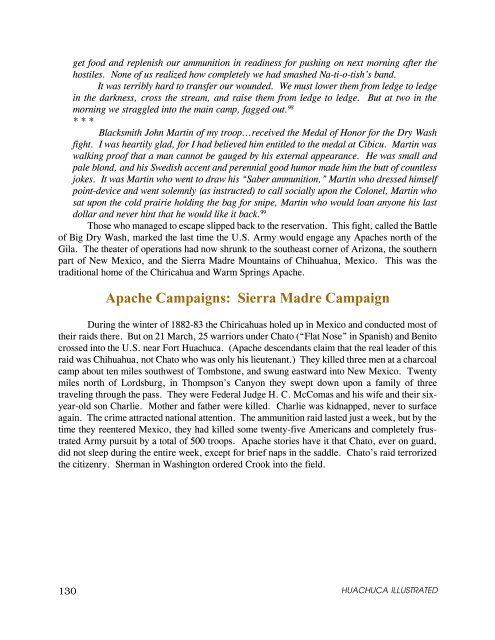Apache Campaigns - Fort Huachuca - U.S. Army
Apache Campaigns - Fort Huachuca - U.S. Army
Apache Campaigns - Fort Huachuca - U.S. Army
Create successful ePaper yourself
Turn your PDF publications into a flip-book with our unique Google optimized e-Paper software.
get food and replenish our ammunition in readiness for pushing on next morning after the<br />
hostiles. None of us realized how completely we had smashed Na-ti-o-tish’s band.<br />
It was terribly hard to transfer our wounded. We must lower them from ledge to ledge<br />
in the darkness, cross the stream, and raise them from ledge to ledge. But at two in the<br />
morning we straggled into the main camp, fagged out. 98<br />
* * *<br />
Blacksmith John Martin of my troop...received the Medal of Honor for the Dry Wash<br />
fight. I was heartily glad, for I had believed him entitled to the medal at Cibicu. Martin was<br />
walking proof that a man cannot be gauged by his external appearance. He was small and<br />
pale blond, and his Swedish accent and perennial good humor made him the butt of countless<br />
jokes. It was Martin who went to draw his “Saber ammunition,” Martin who dressed himself<br />
point-device and went solemnly (as instructed) to call socially upon the Colonel, Martin who<br />
sat upon the cold prairie holding the bag for snipe, Martin who would loan anyone his last<br />
dollar and never hint that he would like it back. 99<br />
Those who managed to escape slipped back to the reservation. This fight, called the Battle<br />
of Big Dry Wash, marked the last time the U.S. <strong>Army</strong> would engage any <strong>Apache</strong>s north of the<br />
Gila. The theater of operations had now shrunk to the southeast corner of Arizona, the southern<br />
part of New Mexico, and the Sierra Madre Mountains of Chihuahua, Mexico. This was the<br />
traditional home of the Chiricahua and Warm Springs <strong>Apache</strong>.<br />
130<br />
<strong>Apache</strong> <strong>Campaigns</strong>: Sierra Madre Campaign<br />
During the winter of 1882-83 the Chiricahuas holed up in Mexico and conducted most of<br />
their raids there. But on 21 March, 25 warriors under Chato (“Flat Nose” in Spanish) and Benito<br />
crossed into the U.S. near <strong>Fort</strong> <strong>Huachuca</strong>. (<strong>Apache</strong> descendants claim that the real leader of this<br />
raid was Chihuahua, not Chato who was only his lieutenant.) They killed three men at a charcoal<br />
camp about ten miles southwest of Tombstone, and swung eastward into New Mexico. Twenty<br />
miles north of Lordsburg, in Thompson’s Canyon they swept down upon a family of three<br />
traveling through the pass. They were Federal Judge H. C. McComas and his wife and their sixyear-old<br />
son Charlie. Mother and father were killed. Charlie was kidnapped, never to surface<br />
again. The crime attracted national attention. The ammunition raid lasted just a week, but by the<br />
time they reentered Mexico, they had killed some twenty-five Americans and completely frustrated<br />
<strong>Army</strong> pursuit by a total of 500 troops. <strong>Apache</strong> stories have it that Chato, ever on guard,<br />
did not sleep during the entire week, except for brief naps in the saddle. Chato’s raid terrorized<br />
the citizenry. Sherman in Washington ordered Crook into the field.<br />
HUACHUCA ILLUSTRATED

















